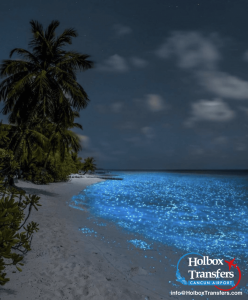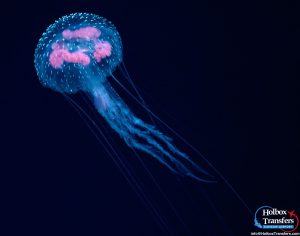Visit HOLBOX and amaze yourself with the spectacular scenery of the Bioluminescent Coast. Holbox bioluminescence is a phenomenon that occurs on the southern beaches of the island and can be observed when there is no moonlight, allowing you to see a peculiar coast that shines with its own light.
This phenomenon is present almost all year round in Holbox, but darkness is needed to appreciate it better. That is why the best months are from April to November. However, in July you can also see the whale shark, so you can take advantage and experience both experiences.

What animals have it?
Animals that have bioluminescence are bacteria, phytoplankton such as dinoflagellates, animals such as ctenophores, some fish and squid, some jellyfish and shrimp.
Among the most emblematic are abyssopelagic fish, fish that are found in the oceanic zone that goes from 3,000 to 6,000 depth, such as the lofiformes (lantern fish). The females have a bait of shiny meat that attracts prey to come closer and capture it more easily.
Hawaiian squid light up with bioluminescent bacteria that live in one of their organs. Thus, the light camouflages them against the moonlight on the surface and eliminates their shadow, hiding them from predators.
Some animals of the ctenophore phylum, such as the Nuez de mar (Mnemiopsis leidyi), have photophores, organs that emit light, inside their bells that refract light, producing a bright rainbow that surprises predators.
There’s also the world’s smallest shark, the 6-inch lantern shark, which promotes itself by using photophores (light-producing organs) around its reproductive organs.



Holbox Transfers
What is it for?
Bioluminescence is used by marine animals to camouflage, distract, defend, communicate and find prey.
The dinoflagellates light up at the slightest contact or when the water is stirred because it serves to attract the predator of its predator, since they are very small organisms incapable of moving quickly. When the small crustaceans devour dinoflagellates and disturb the water, they produce light illuminating the crustaceans left at the mercy of the fish.
Some creatures such as shrimp (Sergestes similis), some fish, and many squid use light by illuminating their belly in a way that makes it similar to light from the surface. This allows them to camouflage. The shrimp Sergestes similis, for example, can dose the amount of light it emits according to the brightness of the water around it.
And others, such as deep-sea squid, use it to scare a predator and have time to escape from it. They produce a burst of light and disappear into the darkness.


















